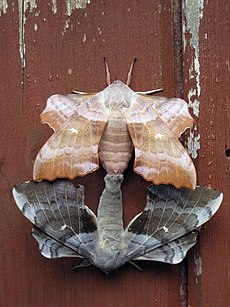Our website is made possible by displaying online advertisements to our visitors.
Please consider supporting us by disabling your ad blocker.
Moth
| Moths | |
|---|---|

| |
| Emperor Gum Moth, Opodiphthera eucalypti | |
| Scientific classification | |
| Kingdom: | |
| Phylum: | |
| Class: | |
| Order: | |



Moths are insects of the order Lepidoptera. They are closely related to butterflies, which evolved from them. They also have wings, just like butterflies. Most species of moths are active only at night. They can be told apart from butterflies in several ways. Moth antenna look like little feathers, and their wings are held flat on their backs when they are not flying.
Most Lepidoptera are moths. There are thought to be about 160,000 species of moths (nearly ten times the number of species of butterflies).[1] Thousands of species are still to be described. Most moths are tiny: they are called micromoths or microlepidoptera. The large moths are much better known, but fewer. Most species of moths are nocturnal, but not all. There are crepuscular and diurnal species.
Previous Page Next Page


